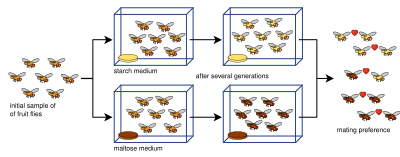
Back آزمایشهای گونهزایی در آزمایشگاه Persian Experimentos de laboratorio de especiación Galician 종분화 실험 Korean

Laboratory experiments of speciation have been conducted for all four modes of speciation: allopatric, peripatric, parapatric, and sympatric; and various other processes involving speciation: hybridization, reinforcement, founder effects, among others. Most of the experiments have been done on flies, in particular Drosophila fruit flies.[1] However, more recent studies have tested yeasts, fungi, and even viruses.
It has been suggested that laboratory experiments are not conducive to vicariant speciation events (allopatric and peripatric) due to their small population sizes and limited generations.[2] Most estimates from studies of nature indicate that speciation takes hundreds of thousands to millions of years.[3] On the other hand, many species are thought to have speciated faster and more recently, such as the European flounders (Platichthys flesus) that spawn in pelagic and demersal zones—having allopatrically speciated in under 3000 generations.[4]
- ^ Cite error: The named reference
Coyne&Orr2004was invoked but never defined (see the help page). - ^ Cite error: The named reference
Florin&Odeen2002was invoked but never defined (see the help page). - ^ Coyne, Jerry A.; Orr, H. Allen (1997), ""Patterns of Speciation in Drosophila" Revisited", Evolution, 51 (1): 295–303, doi:10.1111/j.1558-5646.1997.tb02412.x, PMID 28568795
- ^ Momigliano, Paolo; Jokinen, Henri; Fraimout, Antoine; Florin, Ann-Britt; Norkko, Alf; Merilä, Juha (2017), "Extraordinarily rapid speciation in a marine fish" (PDF), PNAS, 114 (23): 6074–6079, Bibcode:2017PNAS..114.6074M, doi:10.1073/pnas.1615109114, PMC 5468626, PMID 28533412
© MMXXIII Rich X Search. We shall prevail. All rights reserved. Rich X Search